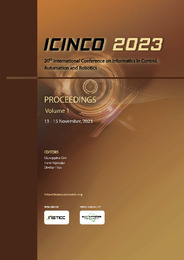Por favor, use este identificador para citar o enlazar este ítem:
https://hdl.handle.net/11000/31574
Computing the Traversability of the Environment by Means of Sparse
Convolutional 3D Neural Networks
Título :
Computing the Traversability of the Environment by Means of Sparse
Convolutional 3D Neural Networks |
Autor :
Santo López, Antonio 
Gil, Arturo 
Valiente, David
Ballesta, Mónica 
Peidro, Adrian  |
Editor :
INSTICC - Institute for Systems and Technologies of Information, Control and Communication |
Departamento:
Departamentos de la UMH::Ingeniería de Sistemas y Automática |
Fecha de publicación:
2023-11 |
URI :
https://hdl.handle.net/11000/31574 |
Resumen :
The correct assessment of the environment in terms of traversability is strictly necessary during the navigation
task in autonomous mobile robots. In particular, navigating along unknown, natural and unstructured
environments requires techniques to select which areas can be traversed by the robot. In order to increase
the autonomy of the system’s decisions, this paper proposes a method for the evaluation of 3D point clouds
obtained by a LiDAR sensor in order to obtain the transitable areas, both in road and natural environments.
Specifically, a trained sparse encoder-decoder configuration with rotation invariant features is proposed to
replicate the input data by associating to each point the learned traversability features. Experimental results
show the robustness and effectiveness of the proposed method in outdoor environments, improving the results
of other approaches.
|
Palabras clave/Materias:
Autonomous Mobile Robots
Artificial Intelligence
Neural Networks
Sparse Convolution
Point Clouds |
Área de conocimiento :
CDU: Ciencias aplicadas: Ingeniería. Tecnología |
Tipo de documento :
info:eu-repo/semantics/article |
Derechos de acceso:
info:eu-repo/semantics/openAccess |
DOI :
https://doi.org/10.5220/0000168300003543 |
Aparece en las colecciones:
Artículos Ingeniería de Sistemas y Automática
|
 La licencia se describe como: Atribución-NonComercial-NoDerivada 4.0 Internacional.
La licencia se describe como: Atribución-NonComercial-NoDerivada 4.0 Internacional.
 La licencia se describe como: Atribución-NonComercial-NoDerivada 4.0 Internacional.
La licencia se describe como: Atribución-NonComercial-NoDerivada 4.0 Internacional.
.png)
